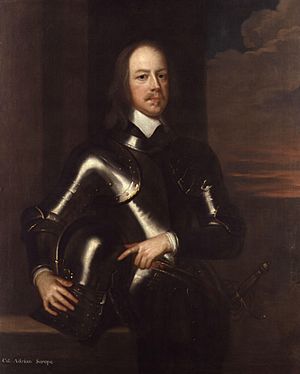Battle of St Neots (1648) facts for kids
Quick facts for kids Battle of St Neots |
|||||||
|---|---|---|---|---|---|---|---|
| Part of the Second English Civil War | |||||||
 Colonel Adrian Scrope, Parliamentarian commander |
|||||||
|
|||||||
| Belligerents | |||||||
| Commanders and leaders | |||||||
| Earl of Holland (POW) Colonel John Dalbier † |
Colonel Adrian Scrope | ||||||
| Strength | |||||||
| 100 to 200 (estimate) | 100 | ||||||
| Casualties and losses | |||||||
| 12 killed or wounded | minimal | ||||||
The Battle of St Neots happened on July 10, 1648. It was a small but important fight during the Second English Civil War. This battle took place in St Neots, a town in Cambridgeshire. A group of Royalist soldiers, led by the Earl of Holland and Colonel John Dalbier, were defeated. They were beaten by 100 experienced soldiers from the New Model Army, who were commanded by Colonel Adrian Scrope.
The Royalists were caught by surprise very early in the morning. They were quickly beaten. Colonel Dalbier and several other Royalists were killed. The Earl of Holland was captured. He was later executed for treason on March 9, 1649. Even though it was a small battle, this victory was very important for the Parliamentarians. It stopped Royalist groups in the East Midlands from gathering together and becoming a bigger threat.
Contents
Why the Battle Happened
England's Civil War Begins
The First English Civil War ended in May 1646. The Royalists lost, and many Parliamentarians thought King Charles I would agree to new rules. But King Charles I did not want to change. For two years, he refused to work with Parliament.
Parliament had gone to war in 1642 to limit the king's power, not to remove him. Most people, even Puritans, believed a king was chosen by God. This made King Charles I a key part of any peace plan.
Divided Sides and New Conflicts
However, his opponents were very divided. There were moderates in Parliament and more extreme groups in the New Model Army. In April 1648, King Charles I's Scottish supporters gained power in Parliament of Scotland. They agreed to help him get his English throne back. This led to a new plan for Scottish and English Royalists to rise up. Some English Presbyterians and Scottish Covenanters also joined them.
The Second English Civil War started in April 1648. The plan was to keep the New Model Army busy with smaller revolts. This would give the Scottish army time to invade England. By the end of June, the revolts in South Wales and Kent were stopped. A Royalist group in Colchester was surrounded by the New Model Army.
Royalists on the Run
On July 4, a request was made to Parliament to talk with King Charles again. On the same day, the Earl of Holland and George Villiers, 2nd Duke of Buckingham gathered 400 horsemen. They tried to take London.
But they didn't have enough men. The Royalists had to retreat through Surrey towards Reigate. They were scattered near Surbiton by Sir Michael Livesey. Most of the Royalists left the fight. But Holland reached St Neots on Sunday, July 9. He had 100 to 200 men and Colonel John Dalbier with him. Dalbier was an experienced German soldier who had fought for Parliament before.
At the same time, Sir Thomas Fairfax sent 100 experienced horsemen. These soldiers were led by Colonel Adrian Scrope. Their job was to stop the Royalists from gathering more supporters in the East Midlands.
The Battle at St Neots
The Royalist soldiers were tired, hungry, and losing hope. A few men under Dalbier guarded the bridge into the town. The rest of their comrades were resting. At 2:00 AM on July 10, Scrope's men attacked them. Colonel Dalbier was killed very early in the fight. Some reports say he died from his wounds later that day.
The fight was fierce, but the Royalists were caught by surprise. They were quickly defeated. The Earl of Holland was captured at an inn in the middle of town. Buckingham managed to escape and eventually went to France. Besides Dalbier, five other Royalists were killed. This included the oldest son of Kenelm Digby, who was an important advisor to King Charles I. He and two others drowned trying to swim across the River Great Ouse.
What Happened Next
Holland's Fate
The Earl of Holland was taken to Windsor Castle. He was held there for the next six months. The Second Civil War ended after the Scots were defeated at the Battle of Preston in August. Colonel Scrope had promised to spare Holland's life. However, Holland had already avoided being tried for treason once before. This was after he joined the Royalists in 1643 and then returned to Parliament's side.
People's feelings had become much stronger, especially towards those who had been pardoned before. In December, moderate members were removed from Parliament by Pride's Purge. This led to the Execution of Charles I on January 30, 1649. Holland was tried for treason on February 27. He was executed on March 9, along with Lord Capell and the Duke of Hamilton. The Duke of Hamilton had been captured at Preston.


